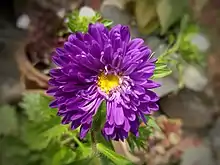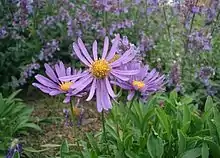Aster (genus)
Aster is a genus of perennial flowering plants in the family Asteraceae. Its circumscription has been narrowed, and it now encompasses around 180 species, all but one of which are restricted to Eurasia; many species formerly in Aster are now in other genera of the tribe Astereae. Aster amellus is the type species of the genus and the family Asteraceae.[1]
| Aster | |
|---|---|
 | |
| Aster amellus | |
| Scientific classification | |
| Kingdom: | Plantae |
| Clade: | Tracheophytes |
| Clade: | Angiosperms |
| Clade: | Eudicots |
| Clade: | Asterids |
| Order: | Asterales |
| Family: | Asteraceae |
| Tribe: | Astereae |
| Genus: | Aster L., 1753 |
| Type species | |
| Aster amellus | |
| Synonyms[2] | |
| |
The name Aster comes from the Ancient Greek word ἀστήρ (astḗr), meaning "star", referring to the shape of the flower head. Many species and a variety of hybrids and varieties are popular as garden plants because of their attractive and colourful flowers. Aster species are used as food plants by the larvae of a number of Lepidoptera species—see list of Lepidoptera that feed on Aster. Asters can grow in all hardiness zones.
Circumscription

The genus Aster once contained nearly 600 species in Eurasia and North America, but after morphologic and molecular research on the genus during the 1990s, it was decided that the North American species are better treated in a series of other related genera. After this split there are roughly 180 species within the genus, all but one being confined to Eurasia.[3]
The New World species have now been reclassified in the genera Almutaster, Canadanthus, Doellingeria, Eucephalus, Eurybia, Ionactis, Oligoneuron, Oreostemma, Sericocarpus and Symphyotrichum, though all are treated within the same tribe, Astereae. Regardless of the taxonomic change, most are still widely referred to as "asters", or "Michaelmas daisies", because of their typical blooming period. See the List of Aster synonyms for more information.
Some common species that have now been moved are:
- Aster breweri (now Eucephalus breweri) – Brewer's aster
- Aster chezuensis (now Heteropappus chejuensis) – Jeju aster
- Aster cordifolius (now Symphyotrichum cordifolium) – blue wood aster
- Aster dumosus (now Symphyotrichum dumosum) – rice button aster, bushy aster
- Aster divaricatus (now Eurybia divaricata) – white wood aster
- Aster ericoides (now Symphyotrichum ericoides) – heath aster
- Aster integrifolius (now Kalimeris integrifolia) – thick-stem aster
- Aster koraiensis (now Miyamayomena koraiensis) – Korean aster
- Aster laevis (now Symphyotrichum laeve) – smooth aster
- Aster lateriflorus (now Symphyotrichum lateriflorum) – "Lady in Black", calico aster
- Aster meyendorffii (now Galatella meyendorffii) – Meyendorf's aster
- Aster nemoralis (now Oclemena nemoralis) - bog aster
- Aster novae-angliae (now Symphyotrichum novae-angliae) – New England aster
- Aster novi-belgii (now Symphyotrichum novi-belgii) – New York aster
- Aster peirsonii (now Oreostemma peirsonii) – Peirson's aster
- Aster protoflorian (now Symphyotrichum pilosum), frost aster
- Aster scaber (now Doellingeria scabra ) – edible aster
- Aster scopulorum (now Ionactis alpina) – lava aster
- Aster sibiricus (now Eurybia sibirica) – Siberian aster
The "China aster" is in the related genus Callistephus.
Species

In the United Kingdom, there is only one native member of the genus, Aster tripolium, the sea aster. The species formerly known as Aster linosyris (Goldilocks) is now Galatella linosyris. Aster alpinus subsp. vierhapperi is the only species native to North America.[2] Many species and a variety of hybrids and varieties are popular as garden plants because of their beautiful, attractive and colourful flowers. Aster species are used as food plants by the larvae of a number of Lepidoptera species—see list of Lepidoptera that feed on Aster. Asters can grow in all hardiness zones.
Some common species are:
- Aster ageratoides – rough-surface aster
- Aster alpinus – alpine aster
- Aster amellus – European Michaelmas daisy, Italian aster
- Aster arenarius – beach-sand aster
- Aster fastigiatus – highly-branch aster
- Aster glehnii – Ulleungdo aster
- Aster hayatae – Korean montane aster
- Aster hispidus – bristle-hair aster
- Aster iinumae – perennial false aster
- Aster incisus – incised-leaf aster
- Aster lautureanus – connected aster, mountain aster
- Aster linosyris – goldilocks aster
- Aster maackii – Maack's aster
- Aster magnus – magnus aster
- Aster neoelegans
- Aster spathulifolius – seashore spatulate aster
- Aster tataricus – Tatarian aster, Tatarinow's aster
- Aster tonglingensis[4]
- Aster tongolensis
- Aster tripolium – sea aster, seashore aster
Hybrids and cultivars
Those marked agm have gained the Royal Horticultural Society's Award of Garden Merit.
In history
The Hungarian revolution of 31 October 1918, became known as the "Aster Revolution" due to protesters in Budapest wearing this flower.[11]
References
- Elizabeth Pennissi (2001). "Linnaeus's last stand?". Science. 291 (5512): 2304–2307. doi:10.1126/science.291.5512.2304. PMID 11269295. S2CID 83724152.
- Luc Brouillet. "Aster Linnaeus, Sp. Pl. 2 : 872. 1753; Gen. Pl. ed. 5, 373. 1754". Flora of North America. p. 20. in Flora of North America.
- Luc Brouillet, Theodore M. Barkley & John L. Strother. "Asteraceae Martinov tribe Astereae Cassini, J. Phys. Chim. Hist. Nat. Arts. 88: 195. 1819". Flora of North America. p. 3. in Flora of North America.
- "Convergent Origin of the narrowly lanceolate leaf in the Genus Aster—with Special Reference to An Unexpected Discovery of A New Aster Species from East China". Novataxa. 2019-01-27. Retrieved 11 February 2019.
- Floridata: Aster × frikartii
- "RHS Plant Selector - Aster × frikartii 'Mönch'". Retrieved 15 July 2013.
- "RHS Plant Selector - A. × frikartii 'Wunder von Stäfa'". Retrieved 15 July 2013.
- Klein, Carol (2004-10-22). "Blazin' squad". Telegraph. Retrieved 15 July 2013.
- "RHS Plant Selector - Aster 'Ochtendgloren'". Retrieved 15 July 2013.
- "RHS Plant Selector - Aster 'Photograph'". Retrieved 15 July 2013.
- Hajdu, Tibor (1990). "Revolution, Counterrevolution, Consolidation". In Peter F. Sugar (ed.). A History of Hungary ([New printing]. ed.). Bloomington: Indiana University Press. p. 297. ISBN 0253355788.